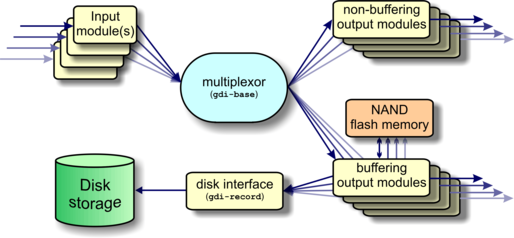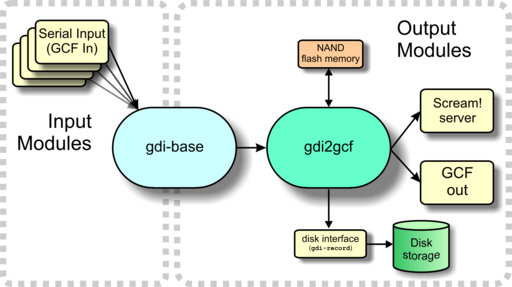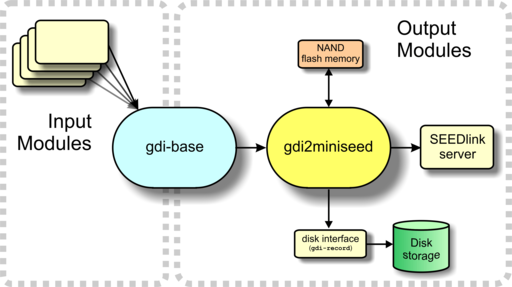
Chapter 5. Data Handling Overview
The data handling system of the CMG-EAM is very flexible, due to its modular software architecture. All data flowing through the CMG-EAM is routed through a single multiplexor module called gdi-base. This communicates directly with all input modules, which handle the various incoming data streams, and all output modules, which convert the data into the required formats. All incoming data is stored and accessed internally in an intermediate format, regardless of the format in which it was originally received.
The diagram below shows the basic internal organisation of the CMG-EAM, ignoring the CD1.1 subsystem.

The multiplexor makes incoming data available to the output modules. These come in two flavours: simple modules (such as those for WIN, GSMS and QSCD) simply convert the data streams and output them in the required format; other modules maintain a ring-buffer which is used to, for example, satisfy BRP back-fill requests. The ring-buffers use the NAND flash memory. These output modules also send data to gdi-record, which handles all hard disk writing requests, regardless of format.
The gdi-base and gdi-record programs are designed to be stateless, so that the data on the disk are always consistent. This means the system is tolerant of the power or disk being removed at any time.
Any number of input modules can be configured to acquire data in any supported format from any source, simultaneously. These modules convert their data and pass it to the multiplexor. Data can be acquired in any of the following formats, from multiple sources:
BRP via serial lines;
Scream via 100BaseTX Ethernet or ppp;
GDI-link via 100BaseTX Ethernet or ppp; and
CD1.1
The architecture has been designed to support the addition of extra formats simply by adding input modules. Please contact Güralp Systems if you have requirements which are currently unsupported.
Any number of output modules can be configured to send data in any supported format to any destination. The following data formats are supported:
GCF output via serial port or TCP stream;
GCF output via Scream (TCP or UDP);
GDI (Güralp Data Interconnect);
GDI-link;
CD1.1;
WIN format output;
QSCD - Quick Seismic Characteristic Data (designed by KIGAM) output; and
GSMS (Güralp Seismic Monitoring System) output.
In the default, factory configuration, the CMG-EAM is configured to receive serial GCF input on all of its serial ports except Data Out. There is a single chain of data through the multiplexor to a Scream server. Data are also recorded to disk in GCF format. This is shown in the following diagram:

The gdi2gcf module, know as the GCF compressor, is responsible for re-blocking GDI samples into GCF blocks. It provides data to all GCF output modules as well as to the gdi-record module, which writes GCF files to disk. It has a number of configuration options, which are described in section 10.2.
A similar arrange applies to miniSEED data: the gdi2miniseed module provides data to the SEEDlink server and to gdi-record.
